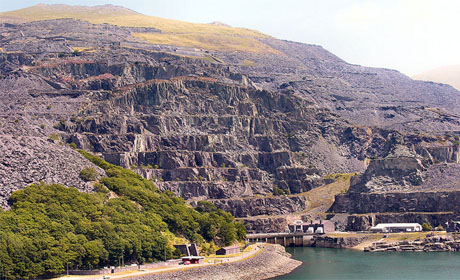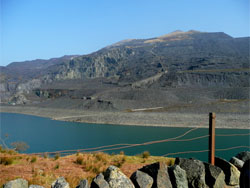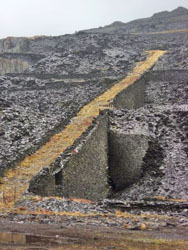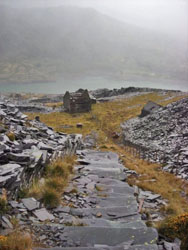Snowdonia/Eryri, Wales

The Dinorwig Power Station is a 1,728 megawatts pumped-storage hydroelectric scheme, near Dinorwig, Llanberis in Snowdonia national park in Gwynedd, north Wales. It comprises 16 kilometres of tunnels, 1 million tons of concrete, 200,000 tons of cement and 4,500 tons of steel.

The original purpose of the scheme was to deal with the difficulty that the National Grid would have had if the large numbers of nuclear power stations then planned had been built. Nuclear power stations must be run at close to full output all of the time so storage capacity was needed for excess power generated at times of low demand. The stalling of the UK nuclear power programme in the late 1980s and the coincident "dash for gas" increased the network's ability to respond to changes in demand, making the use of pumped storage for day/night load balancing less attractive.
Today, Dinorwig is operated not to help meet peak loads but as a STOR (Short Term Operating Reserve), providing a fast response to short-term rapid changes in power demand or sudden loss of power stations (i.e. when everyone turns the kettle on after Strictly!).

The scheme was constructed in the abandoned Dinorwic slate quarry. To preserve the natural beauty of Snowdonia National Park, the power station itself is located deep inside the mountain Elidir Fawr, inside tunnels and caverns. The project – begun in 1974 and costing £425 million and taking ten years to complete – was the largest civil engineering contract ever awarded by the UK government at the time. The work was undertaken by an Alfred McAlpine / Brand / Zschokke consortium.
12,000,000 tonnes of rock had to be moved from inside the mountain, creating tunnels wide enough for two lorries to pass comfortably, and an enormous cavern 51 metres tall, 180 metres long, and 23 metres wide known as "the concert hall". This has also given rise to the station's alternative name of Electric Mountain. The power station is connected to the National Grid substation at Pentir by 400 kV cables that are buried for approximately 10 kilometres , rather than using transmission towers or pylons to transmit the electricity across an area of outstanding natural beauty.

Water is stored at a high altitude in Marchlyn Mawr reservoir and is discharged into Llyn Peris through the turbines during times of peak electricity demand. It is pumped back from Llyn Peris to Marchlyn Mawr during off-peak times. Although it uses more electricity to pump the water up than it generates on the way down, pumping is generally done at periods of low demand, when the energy is cheaper to consume. Another important feature of Dinorwig is that it has been designed to assist restarting the National Grid on the occasion of a complete power failure (a black start). It includes diesel generators and large batteries which would allow the plant to restart even in the event of a complete shutdown of the grid (Dinorwig is not unique in this respect as some fossil-fuel plants are also able to self-start).
The power station is also promoted as a tourist attraction, with visitors able to take a minibus trip to see the workings inside the so-called "Electric Mountain".
Visitors to the above-ground workings should take great care as the crumbling buildings can be dangerous.
Nominated by: Selection Committee